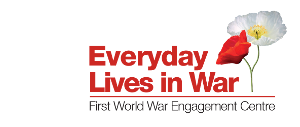Contributed by Ciara Meehan, University of Hertfordshire

Sunshine and swans greeted delegates arriving at The National Archives in Kew today for the Voices of the Home Fronts conference, which has been almost two years in the making. Welcoming delegates on behalf of the Everyday Lives in War centre to the first keynote session, Owen Davies explained how the organising team had been keen to plan a conference that brought together academics – both established and upcoming – and community groups, and which cut across geographical boundaries. For the team, having a conference that explored Home Fronts, rather than the British Home Front, was important to establishing connections and understanding how different communities negotiated the patterns of everyday life. The varied programme is a testament to the response the call for papers received.
Introducing the keynote speaker, Maggie Andrews spoke about how influential Adrian Gregory’s work on the First World War has been. Over the course of the next forty-five minutes, Professor Gregory reflected on the response of the British working classes to the outbreak of war, observing that they were both unified and diverse. He outlined how they had militant capabilities and the power to exercise it, but ultimately they did not rebel against the outbreak of war or Britain’s intervention. He concluded his paper by positing the view that the British working class was right not to impede the war effort, because the implications for everyday life could have been far greater.

Above: One of the letters that Katie Fox used in her presentation. Opening her paper she posed the question, did all levels of society contribute to the British financial effort? In showing that they did, she referred to the poorer elements of society who sometimes sent belongings, such as a ring or bracelet, in an effort to contribute. The government typically declined these gifts and returned them with a polite letter. For some senders, this response prompted disappointment (as seen in this letter held by The National Archives).
We were off to a stimulating start as the audience then divided into one of two parallel sessions. I went to listen to the papers in the media session, while Julie Moore covered the Literature and Poetry session for our twitter feed. In my session, we were treated to papers on Kodak advertising in America, the reaction of the Welsh media to British intervention in the war, newspaper coverage in Devon of low recruitment levels, and an assessment of the British public’s contribution to the government’s war pot. The latter paper, by Katie Fox, drew on an under-utilised collection of papers held by The National Archives, and it was great to get an insight into some of the sources still to be fully mined by historians. Though organised together under the umbrella term of ‘media’, the papers had far more in common. Patriotism and its different forms was a common theme that ran through all four presentations.

Lucie Whitmore noted how women’s fashions in 1914/15 were influenced by military styles, particularly evident in this photo in the button detailing.
Up next was a panel on unusual sources. Such is the diversity of material beyond the traditional that people are working on, we had a parallel session on the same topic. In the one I attended, we heard from Lucy Moore about exhibitions on display at the Museum of the Philosophy and Literary Society in Leeds during the War, prompting us to think about the ordinariness of everyday life during an extraordinary period of history. This was followed by another paper that considered the curatorial process, but in the present context. Sonja Andrew spoke about efforts to preserve, in different ways, the graffiti etched into the walls of the now crumbling Richmond Castle by conscientious objectors. Her paper was followed by Lucie Whitmore, who continued the theme of exploring material culture to interrogate the past. Lucie’s paper considered changing First World War fashion and the crossover between military and civilian styles. Jim Beach, a member of the Everyday Lives in War centre, closed out the session. Drawing on the subject of one of the blog posts for the conference website, Jim spoke of how Vince Schurhoff’s wartime diary can offer a wonderful insight into the everyday lives of soldiers beyond the fighting.
The day was rounded off with a series of lively talks by Professor Maggie Andrews of the University of Worcester, author and historian Richard van Emden, and actor Paul McGann.

Interviewed by Jessamy Carlson of The National Archives, Paul McGann explained how the shadow of World War One was ever-present as he grew up.
Our conference was tweeted by members of the Everyday Lives in War centre using our official twitter account (@FWWLives) and our special ‘live’ accounts (@FWWLives_Live1 and @FWWLives_Live2).

Members of the Centre for Everyday Lives and the Centre for Hidden Histories planning our social media strategy!
We were also joined in our efforts to cover the day’s events by Dr Fionnuala Walsh, who was one of the recipients of our social media bursaries. The tweets from day one have been archived here.
The conference continues tomorrow with another day of exciting and varied papers. Follow the coverage on twitter using the hashtag #HomeFrontVoices.
Originally posted on the 8th September, 2016


